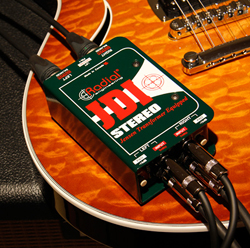In audio there are inputs and outputs, sometimes called sources and destinations. Audio input sources break down into two basic types: microphones and direct inputs (DI), which also stands for “direct injection.” We commonly refer to the devices that perform this function as a direct box, a DI box, or a DI for short.
The various kinds of microphones utilized in pro audio are acoustic-to-electric transducers that convert sound waves in the air into electrical signals. A DI, on the other hand, converts an existing electrical signal without taking it from the air.
Direct boxes have many advantages over microphones. If they’re passive, they require no batteries or phantom power and can, in general, handle high transient levels without distortion. They also provide extremely predictable and consistent sound, as they’re a closed circuit and immune from stage and venue changes from one performance to the next. Aside from musicians changing the volume on their instrument, DIs offer repeatable console gain and EQ settings.
The total isolation from ambient sounds make DI inputs impervious to adjacent sound sources, allowing engineers to turn them up without adding the bleed of nearby players that can “pollute” the signal. Unlike mics on stands, a DI’s location doesn’t affect its sound, so other than its switches, it can’t be accidentally misadjusted.
Finally, DI inputs often provide improved gain-before-feedback, allowing acoustic instruments to be mixed with loud sources, such as a string quartet with a rock band.
A direct box interfaces unbalanced musical instrument or consumer audio signals to balanced signals that can travel longer distances to be used with pro audio consoles, converting high impedance to low impedance, Transformer-equipped passive DIs have the benefit of providing isolation from the hum and buzz of ground loops.
Two Types
There are two basic types of DI: passive and active. A simple rule of thumb is that if the source is active, use a passive DI, one that employs a transformer. If the source is passive, use an active DI, one that uses phantom power. For example, with an old Fender Precision bass (with magnetic pickups), an active DI will probably work best as its buffer will generate plenty of signal for the console. It also will not load the pickup or affect the sound on stage.
On the other hand, a high-output active bass employing its own 9-volt battery can be used in confidence with a passive DI, knowing that its transformer will easily handle the signal without distortion. That said, most active DIs have input pads to reduce signal by 15 to 30 dB.
The electrical symbol for transformers uses two squiggly lines representing coil windings separated by straight lines signifying the laminated steel or nickel core between them. Current passing through the primary winding creates a magnetic field in the transformer’s core that produces a sympathetic current in the secondary winding, effectively passing a signal from one circuit to another without the two being physically connected.
The strength of the secondary signal relative to the first is determined by the ratio of the number of primary windings to the number of the secondary windings. The world’s best transformer manufacturers, such as Jensen, have made models specifically designed for direct box applications for decades. Direct box transformers are typically 12:1.
At its “core” (pun intended), every passive DI is a transformer with an input jack for the instrument, an unbalanced thru connection for the stage amp, and a male XLR for the mixing board’s balanced mic input pre-amp. In the golden age of audio, all technicians could solder, since most snakes, stage boxes and many cables were made by hand from scratch, along with the best passive DIs money could buy. Installing and wiring the connectors and transformer into a project box to make a passive DI was a rite of passage.
















